| |
 (1615 DOCUMENT) (1615 DOCUMENT) |
|
|
|
|
| |
Price: $250.00 |
Stock# 4433 |
| |
(1615 ENGLISH DOCUMENT). DS. 1pg. 15 ½” x 7 ½”. 1615. England. A vellum deed signed “Walter Browne” and “William” on the front and “Lancelot Grymsleave” twice on the back. The document concerns a release for Edward Beere. The document has two vertical folds and a couple of lesser horizontal ones. The writing is dark and the vellum is in very fine condition. A terrific example of a four century old document. |
4433
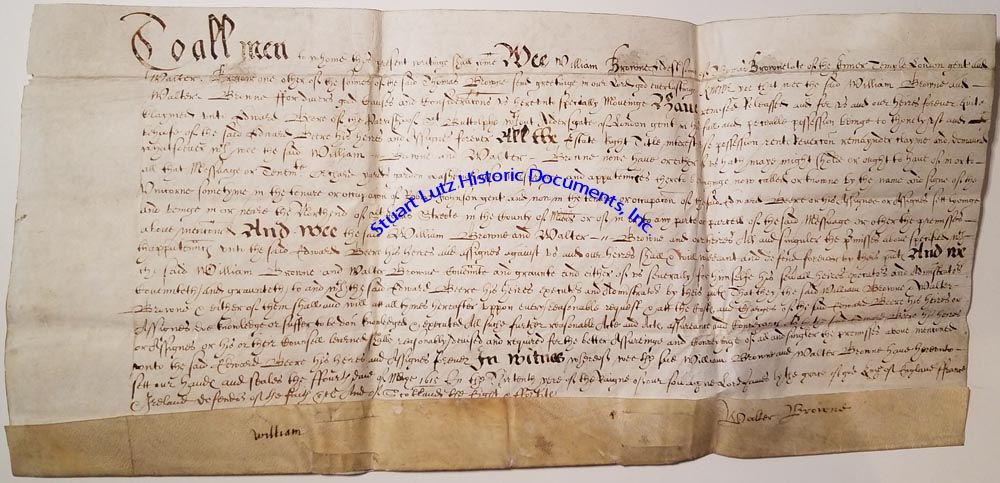
|
|
| |
| |
 (1910s TRAVEL PHOTO ARCHIVE) (1910s TRAVEL PHOTO ARCHIVE) |
|
|
|
|
| |
Price: $750.00 |
Stock# 4259 |
| |
AN EARLY-1900S PHOTO ALBUM OF IMAGES FROM INDIAN, ASIA, AND EUROPE
(TRAVEL PHOTO ALBUM). An album of 189 photographs, mostly of India and China or Japan in the early Twentieth Century. They show local life, architecture, gatherings, the Taj Mahal, a snake charmer, a cremation, elephants, landmarks, animals, local life, the landscape, Asian temples, bridges, city housing, the ocean, and more. There are also images of Europe, including rural towns, country houses, Venetian canals, and churches. Most of the images are printed in sepia tones on cardstock, suggesting that they were purchased rather than developed from a personal camera. It’s likely that these were collected during one or more extended sightseeing trips. Only a few in the back seem to be printed on photographic paper; one of these is dated 1913 on the verso. The images are collected in a new cardboard photo album with cellophane pages. The cardstock images are all in fine condition, while those on photographic paper are in good condition. This collection gives a close-up view of Indian and Asian life in turn-of-the-century, specifically its compelling blend of old traditions and new, western influences. The European images provide picturesque views as well. |
4259
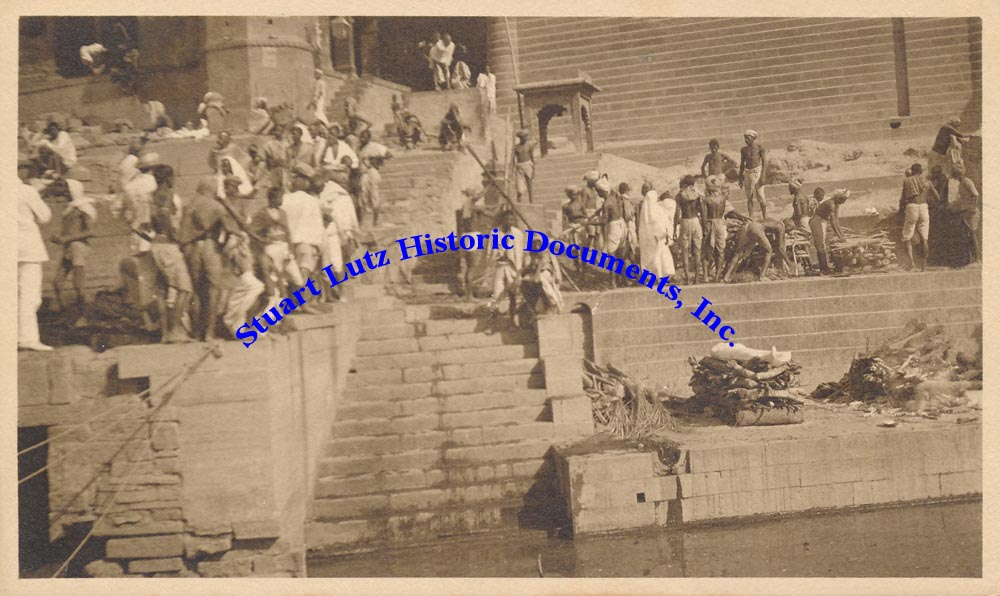
|
|
| |
| |
 (1950 JAPAN DIARY & PHOTO ALBUM) (1950 JAPAN DIARY & PHOTO ALBUM) |
|
|
|
|
| |
Price: $375.00 |
Stock# 4696 |
| |
THE DIARY OF AN AMERICAN OFFICER STATIONED IN JAPAN IN 1950; IT INCLUDES DOZENS OF PHOTOGRAPHS OF LABOR PROTESTS AND THE OFFICER’S COMMENTS ABOUT THE UNREST AND COMMUNISM
(JAPAN). Diary. January 14, 1950 to late 1954. Various places [Philadelphia, Japan, Fort Meade]. A lengthy diary of an American officer, Lieutenant Louis T. Holtz, who was stationed in Japan during the Korean War. It was written on dozens of sheets of loose-leaf notebook pages, and it contains many black and white photographs with captions, as well as newspaper and magazine cutouts and brochures from places he visited. The diary begins on January 14, 1950 in Philadelphia, and he discuses seeing shows and such, but notes that “All in all, this constituted a very enjoyable ten days of leave prior to going overseas. Sometimes I wish I could stay at home and live a normal routine life like everyone else. Other times, I find myself eager to go…Almost two years ago, who could forecast a war in Korea and the manner in which it would rip everyone’s life to shreds?” He writes on January 2, 1951 from Kurume, Japan: “…perhaps 10 years from now, it [the diary] will be of interest – if any of our civilization remains in 1961…I collapsed 28 June and spent 3 weeks in the hospital with excessive fatigue…I am the Officer-in-charge of the Kurume Office with an area of jurisdiction of approximately 1,000 square miles…”. In April 1951, he mentions “I am very busy in my position as OIC [Officer In Charge]. It’s a full 7-day-a-week job…The Korean mess has everyone guessing as to eh future of the Far East…being the senior official in an area of jurisdiction of nearly 1,0000 square miles with dozens of mayors and police chiefs constantly catching my every word as official..”. The next couple dozen pages contain black and white photographs of protests in Japan, and Holtz’s commentary about the images, including “When people get hurt, propaganda fills the air. The winner: the Kremlin – always!”, “Demonstrations take planning and people. You can always be sure the plans were framed in red and the spectators sprinkled liberally with dye-hard communist stooges”, “Demonstrations & rallies are usually fantastically well organized. And as often as not, they can be unbelievably orderly” and “But orderly or violent, you can always be sure there is a professional communist keeping the ‘sheep’ in line or arousing them to maximum fury.” In September 1951, Holtz writes from Sapporro “…life in the Armed Services has been a miserable one because of one bad experience after another…Kurume was one of the most pleasant and enjoyable assignments I ever held. The 45th was, without doubt, the most bitter and least enjoyable. I gave up so much for so little…”. Holtz was in California’s Camp Stoneman in November 1951: “…with all the hundreds of officers here not particularly anxious to go overseas and with several actually fighting the assignment, I was amazed to find that someone eager to return is sidetracked so abruptly…”. He was back in Japan by December and then wrote a lengthy entry entitled “The Korean Story”, starting with “Combat precautions make it mandatory that no diaries or personal papers be kept where they may fall into enemy hands” and he spends the next seven pages describing his experiences in the Korean War. Holtz wrote in part: “…Things had not gone well at all with Trubota’s unit prior to August 1951. After my arrival, working results proved very satisfactory…Three other officers has also joined up in the interim between leaving Sapporo and going to Korea…When oriented in Tokyo, they were told that the 45th Detachment would remain in Sapporo and they had already alerted their families to start to prepare to join them overseas…I had to fight Trubota in order to be able to fight the enemy. In one occasion, I was reprimanded for going to a forward observation post and not being personally available to answer the telephone at my CP…” and the section finishes with a photograph of the USS Marine Lynx, the ship that brought him home. The diary continues with his being stationed at Maryland’s Fort Meade. There are photographs of the mansion he occupied in Kyushu, Japanese women at the beach, his fellow soldiers after a bowling tournament, etc. There are “Samples of United Nations propaganda leaflets dropped on North Korean positions early in the Korean conflict” that show Truman and MacArthur, a December 7, 1950 letter signed by the mayor of Kurume City, Japan. The condition is fine to very fine. |
4696
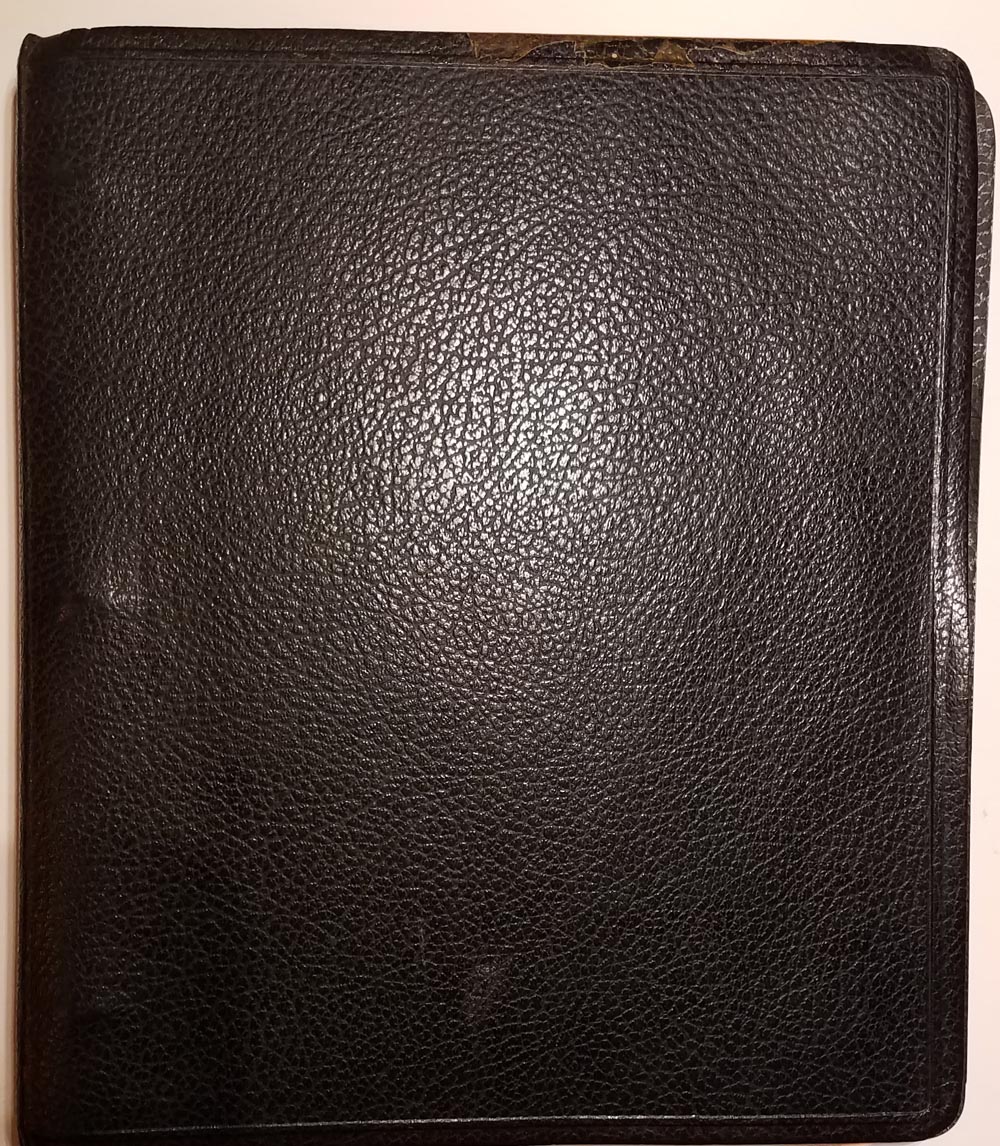
|
|
| |
| |
 (AFRICA NATIVE PLATES) (AFRICA NATIVE PLATES) |
|
|
|
|
| |
Price: $300.00 |
Stock# 570 |
| |
A COLLECTION OF 18TH CENTURY IMAGES SHOWING AFRICAN NATIVES
Vignettes. 6pgs. No date. No place. A collection of six pages, with twelve illustrations, of African natives. They are from an unidentified book, probably from the 18th Century, and are in very fine condition overall. Some of the images show a mother breast feeding, a beheading, combat, and royalty. A fine assembly. |
570

|
|
| |
| |
 (AMERICAN MISSIONARIES IN INDIA) (AMERICAN MISSIONARIES IN INDIA) |
|
|
|
|
| |
Price: $300.00 |
Stock# 4337 |
| |
THREE MISSIONARY LETTERS FROM INDIA IN 1902 TO AN AMERICAN IN SEATTLE
(CHRISTIAN MISSIONARIES IN INDIA). An archive of three letters from Christian missionies in India to E.E. Pelz of Seattle, Washington:
TLS. 1pg. 8 ½” x 11”. March 5, 1902. Allahabad, India. A typed letter signed “Rockwell Clancy” to E.E. Pelz: “I have been transferred from the Allahabad District to the Muttra District. There are more than 12,000 Christians in my new district, and it will be impossible for me to attend to that work to retain the secretary ship of the Bishop Thoburn Special Fund for India... Mr. Rockey is a missionary of many years experience, and is not new to the work of the special fund, as he was secretary before I took over the work from him at the beginning of 1895, when he went to America on furlough. His name will be familiar to the patrons of 1894 in previous years. I feel sure that anyone who has ever had a letter from him about the work in India will be very glad to know that he is taken up this duty again. Among all are missionaries there are very few men who can write more interestingly of India than Mr. Rockey.… Let me ask you to continue to do all you can to interest others in India. The opportunities for work among the heathen are boundless. Many doors are open to us; thousands would become Christians if we could give them pastors and teachers. I came to India 18 years ago. At that time there were not more than 10,000 Christians in our mission; today there are 128,000. Let us continue to pray and work till India becomes a Christian land.” The letter has chipping along the right edge and is in good condition.
TLS. 1pg. 8 ½” x 11”. April 24, 1902. A typed letter signed “N.L. Rockey” on “The Bishop Thoburn Special Fund For India” letterhead. He wrote to E.E. Pelz: “The latest draft from mission rooms brought to meet your your donation of $15 given in February for the continued support of a pastor – teacher in India. I find from the books that Bro. Clancy turned over to me that you have given on several occasions, but he has made no assignment. I know that it is pleasant for people who give for this fun to have some special man in view, and therefore ascending the sum to the presiding elder of Kasgunj district I asked him to send me the names of men who would be supported by the special fund. One of them I am assigning to you. When you pray and when you give keep Chadmai Lall's maybe for you. He is a pastor – teacher in Kasgunj district. He is 28 years of age. A number of villages must be visited by him. In some of these villages a few Christians live apart from other people despised by their neighbors... This year he has 10 men whom he is seeking to win for Christ. He also teaches a small school which 15 boys are reading...N.L. Rockey”. The letter has a rough right edge.
ALS. 5pg. 5” x 8”. April 24, 1902. Sitaper, India. A lengthy autograph letter signed “N.L. Rockey” to E.E. Pelz: “Several years ago we had the pleasure of receiving from you a donation of $15 for our special fund, but now for some time we've not heard from you. It is possible to the fault is ours and that you do not get a proper acknowledgment of your donation. Our Bro Clancy tried to keep all straight but he has had several men working upon them and the great strain of the famine came, let some of the records get into confusion and the writing had to be left to such helpers as he could secure. You will see by the enclosed that I am now called to this duty and I desire to have brethren in America correspond with me concerning any difficulty in past donations. As far as I can I will trace the matter a reply to your questions. We have been roughly honest with the money you entrusted to us. Over one half of the work in the N.W. India conference has been carried on only through the aid of the special fund that started as promised…$100 would support a full preacher…We would be so glad to enlist your prayers and help to enable us to continue our work. Our missionary society has scattered its obligations on all continents and is not been able to contain its support to India... You can designate your gift for the support of… Scholarships for our native schools or for the support of an orphan or for the endowment of our English schools where our missionaries children are educated. We need a fund that will supply good teachers in these...N.L. Rockey”. The lengthy letter is in fine condition. |
4337
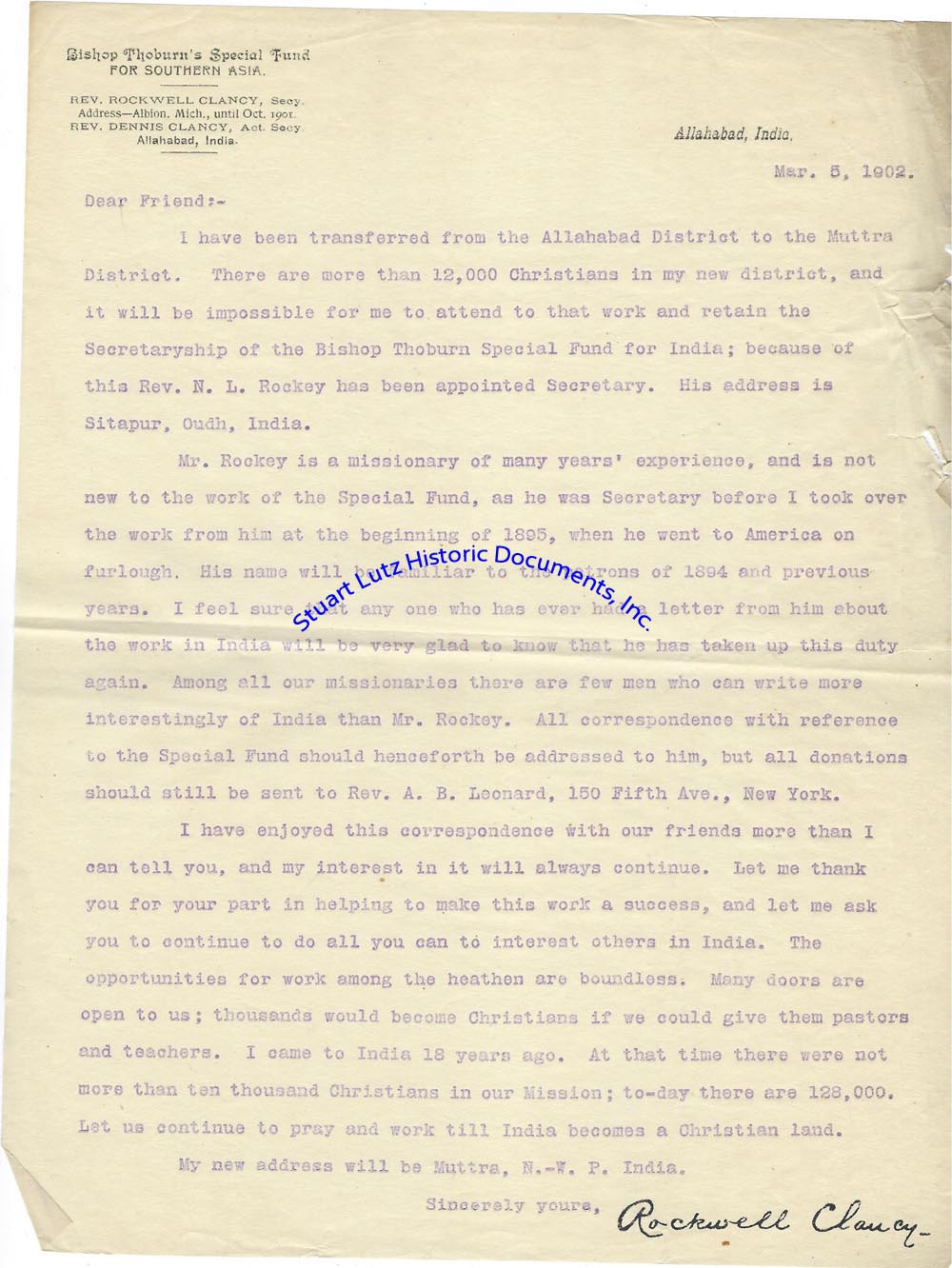
|
|
| |
| |
 (ANTI-SEMETIC LETTERS FROM JAPAN) (ANTI-SEMETIC LETTERS FROM JAPAN) |
|
|
|
|
| |
Price: $100.00 |
Stock# 2060 |
| |
LETTERS OF LIFE AND ANTI-SEMITISM FROM AN AMERICAN ABROAD IN EARLY 20TH CENTURY JAPAN
a) TLS. 2pg. 8 ¼” x 10”. July 15, 1920. Yokohama, Japan. A typed letter signed “Neil” laced with anti-Semitic sentiment. In part: “Went out calling last night with the bunch of fellows across the street. The host and his side partner are N.Y. Jews but sort of decent people. The wife is very nice but the husband is a regular East Sider. He is always talking about ‘not that I mind the expense of the house here but the servant is always telling about the money she needs for this and that and I can’t see where it goes to.’ You know just about what kind of a guy he is better than I do, no doubt, and you haven’t seen him. Anyway it was sort of a pleasant evening, as he left the States in March and brought a lot of the new songs with him. He is a very good piano player and I had a fine time listening to him. One of the songs he played and ‘tried to sing’ just like John was ‘Pal of Mine’ you know how nice it was in comparison to the real singer and this Jew did the same stunt of turning to his wife too, as John does to his wife when she sits up in the box. The husband was just a regular N.Y. smart alex Jew.” Typed on letterhead from Yokohama’s Grand Hotel, which famously burned down as a result of the devastating 1923 Great Kanto earthquake, the letter is in very fine condition, with light toning throughout and a few handwritten corrections not affecting legibility.
b) TLS. 3pg. 8 ¼” x 10”. July 19, 1920. Yokohama, Japan. A typed letter signed “Neil” regarding work and life as an American abroad in early 20th century Japan. In part: “There isn’t much doing as for excitement but just hang around and do nothing. I really think I am gaining weight on the job. I met a fellow here who deals in all sorts of dress goods from Boston and I am getting on the right side of him as he gets all his stuff from here and I may be able to get some things for you people wholesale when you need them. He is one of us (you get me) being from Boston and a very fine chap. Eleanor will have nothing on me then getting things wholesale. About the only thing we need now wholesale is to get a bank to give us more money on our checks when we cash in. I am thinking of buying a kimono for Connors in the office for his wife, as they are married in the Fall. He is a nice fellow and I thought for his trouble in calling up and the like I would bring him back one. I am not sure about it as yet but I think I will.” Typed on letterhead from Yokohama’s Grand Hotel, which famously burned down as a result of the devastating 1923 Great Kanto earthquake, the letter is in very fine condition, with light toning throughout and a few handwritten corrections not affecting legibility. |
2060
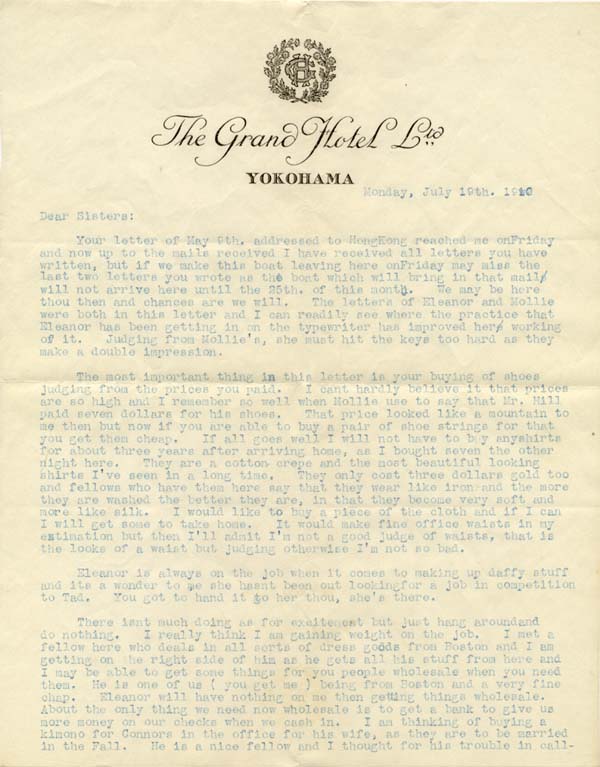
|
|
| |
| |
<Next 6>
|
 |






